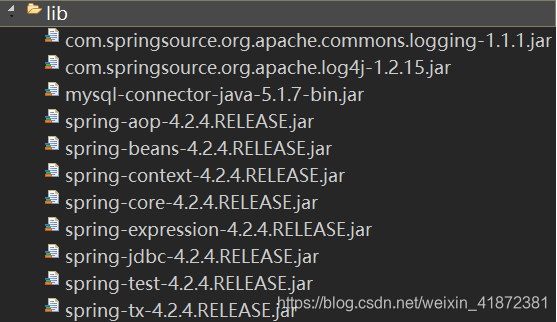Spring_AOP基于AspectJ的注解开发&JDBC的模板使用&事务管理(学习笔记3)
一:AOP基于AspectJ的注解开发
1,简单的实例:
1)引入相应的jar包
2)在配置文件里引入相关约束
3)编写目标类和切面类并配置到IoC容器中,在配置文件中开启注解的AOP开发
4)在编写切面类时即可加入相关的注解
2,注解通知的分类
- @Before(前置通知)
- @AfterReturning(后置通知)
- @Around(环绕通知)
- @AfterThrowing(异常通知)
- @After(最终通知)
- @Pointcut (注解切入点)
二:Spring JDBC模板使用
1,简单实例
1)引入相关jar包
2)将Spring内置连接池和JDBC模板配置到配置文件中
3)编写测试类
2,配置第三方连接池
1)配置dbcp连接池
首先引入dbcp的相干jar包
在配置文件中配置dbcp连接池
2)配置c3p0连接池(常用)
引入相关jar包
在配置文件中配置c3p0连接池
3)将连接池配置信息放入外部文件中,并引入到配置文件中
3,使用JDBC模板进行简单CRUD操作
三:Spring的事务管理
1,事务简介
事务:逻辑上的一组操作,组成这组操作的各个单元,要么全部成功,要么全部失败
事务的特性:
- 原子性(事务不可分割)
- 一致性(事务前后数据保持一致)
- 隔离性(各个事务之间不受干扰)
- 持久性(事务过后,数据应持久保留在数据库中)
事务失去隔离性后引发的问题:
- 脏读:一个事务读取到其他事务未提交的数据
- 不可重复度:一个事务读取到其他事务已提交的update数据
- 幻读:一个事务读取到其他事务已提交的insert数据
- 会引起写入操作的丢失
事务的隔离级别(isolate):
- read uncommitted(未提交读,什么都不能解决)
- read committed(提交读,只解决脏读,oracle默认)
- repeatable read(重复读,只能解决脏读和不可重复读,幻读可能发生,mysql默认)
- serializable(串行化,不允许事务的并行,什么都可以解决,但效率低)
2,Spring事务管理的API
1)PlatformTransactionManager(平台事务管理)
这是一个接口,其中有两个实现类:
- DataSourceTransactionManger:底层通过JDBC管理事务
- HibernateTransactionManger:底层通过Hibernate来管理事务
2)TransactionDefinition(事务定义)
定义事务的隔离级别,超时信息,传播行为,是否只读
3)TransactionStatus(事务状态)
事务是否提交等状态信息
4)事务API之间的联系:
事务管理平台通过事务定义的信息来管理,过程中事务的状态存在TransactionStatus中
3,Spring事务的传播行为(解决Service层方法互相调用的问题,例A方法被B方法调用,但A方法中可能存在事务)
1)保证多个操作在同一个事务中
PROPAGATION REQUIRED(默认) ,如果A中有事务,使用A中的事务,如果A中没有事务,创建一个新的事务将操作包含进来
2)保证多个操作不在同一个事务中
PROPAGATION REQUIRES NEW ,如果A中有事务,则将A事务挂起(暂停),创建一个新事务,只包含自身操作,如果A中没有事务,则创建一个新事务,包含自身操作
3) 嵌套式事务
PROPAGATION NESTED 如果A中有事务,按照A的事务执行,执行完后,设置一个保存点后,执行B的操作,如果没有异常,执行通过,如果有异常,可以回滚到执行A操作前,也可以回滚到执行A操作后(保存点)
4,第一类:编程式事务管理
5,声明式事务管理(底层采用AOP)
注意:引入相关的AOP开发的jar包
1)xml方式(在配置文件中配置)
2)注解方式
配置好后在业务层应用注解:




